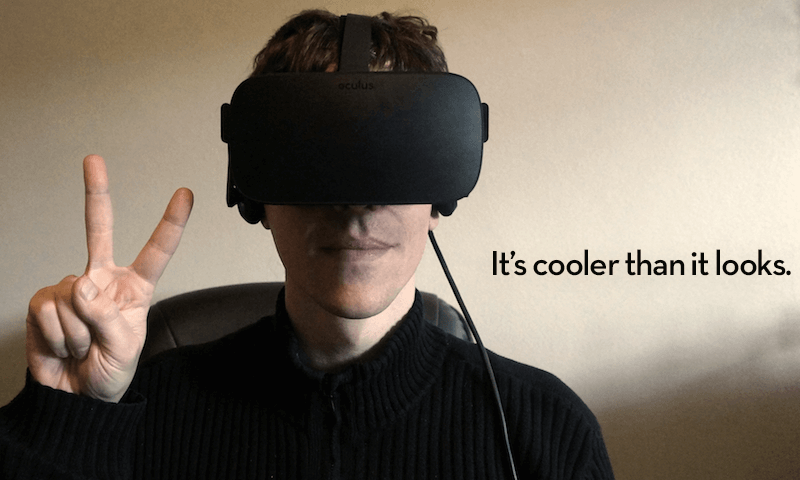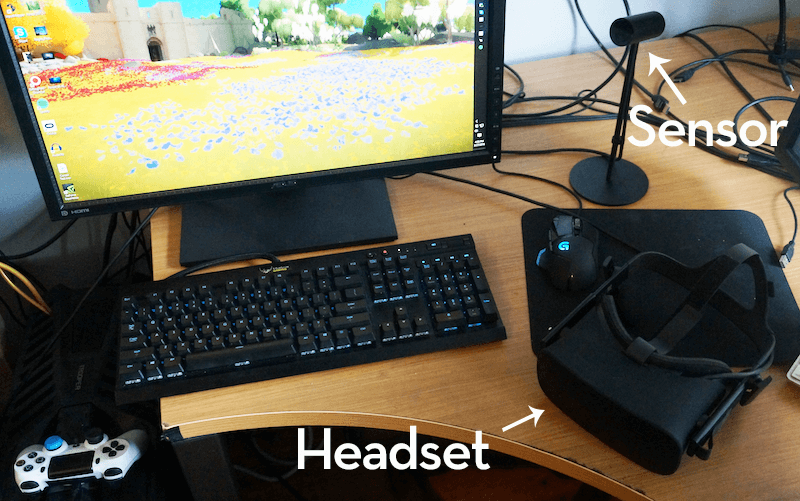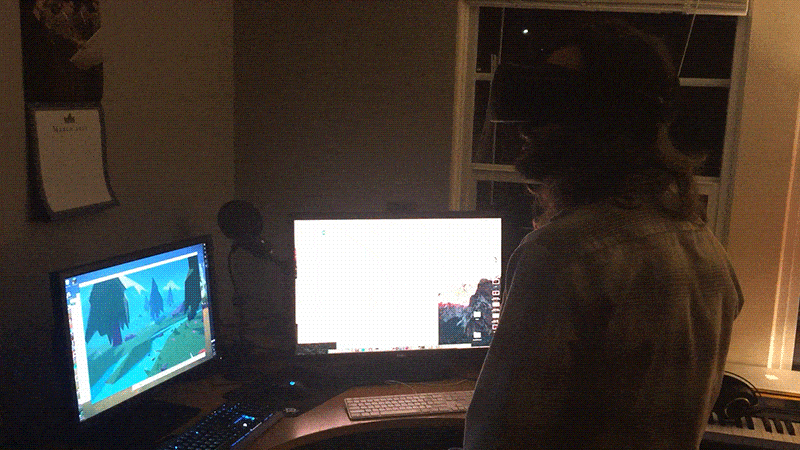 For the past week, I've been strapping a headset to my face and embracing the sensory overload of modern virtual reality. I've watched VR short films and played around 30 VR games, all from the comfort of my own home. I've fought off space raiders, monsters, and VR-induced nausea. Let me tell you all about it.
For the past week, I've been strapping a headset to my face and embracing the sensory overload of modern virtual reality. I've watched VR short films and played around 30 VR games, all from the comfort of my own home. I've fought off space raiders, monsters, and VR-induced nausea. Let me tell you all about it.
A week ago, Oculus sent me one of their commercial Rift headsets, along with a special loaner "Oculus Ready" PC to use with it. Since then, I've been using a pre-release version of their Oculus store and headset operating system, which operates simultaneously within Windows to make the Rift work almost like its own standalone gaming platform.

Like a lot of geeks who grew up with The Matrix and eXistenZ, I've been following the Rift's development with great interest. A couple of summers ago I bought an early development model (née the DK2) and played a boatload of the space sim Elite: Dangerous. It was a fun time, and I've been looking forward to seeing how the final, commercial headset works.

I'll be covering the Rift a lot over the coming week and beyond. For now, on the morning of the almighty embargo lift, I thought I'd share some general impressions after a week of heavy VR usage.
The Basics
The Rift launches this week---Kickstarter backers and anyone who got in an early preorder should get theirs delivered today or in the very near future. It's backordered, and most people will have to wait until June or July. The Rift headset costs $600, which puts it in between its two competitors price-wise: More than the $500 PlayStation VR bundle that launches this fall, less than the $800 HTC Vive, which comes out in early April.
For that price you get the headset, a head-tracking sensor, a small remote control and a wireless Xbox One controller, along with some free bundled software demos and the 3D platforming game Lucky's Tale. The Rift will work with a pair of the interesting-sounding Oculus Touch controllers, but those aren't out yet and will presumably cost more on top of the headset's initial price. By the time all is said and done, I assume the complete Rift and the Vive (which already comes with special handheld VR controllers) will cost about the same amount.
The Rift comes in a cool box. It's the sort of box a $600 piece of electronic equipment should come in. If you want to see it in the box, there are probably already some unboxing videos on YouTube. Here's how it looks placed amid my actual desktop gaming setup:

It's pretty straightforward. It's a black headset. What did you expect? On with the impressions.
It's cool.
Let's get this one out of the way first: The Oculus Rift is cool. At its best, it's really cool. It mostly comes down to something the people at Oculus call "presence," which sounds like a vague buzzword but turns out to be a useful concept. Presence comes from some combination of visual fidelity, a high screen refresh rate, responsive head tracking, and a clean 3D effect. It's a thing that I will work very hard to try to convey with words, gifs and videos over the coming days, but in the end you really just have to see it for yourself.
The best I can do is... okay. Look at your hand. Move it around. Now move your head closer to your hand. You know how you can just intuitively tell you're looking at a real thing in front of your actual face? VR Presence is a little like that. When it's dialed in, things look like they're right there in front of you.
The Rift has plenty of issues and, generally speaking, it's not a device I recommend to just anyone. It may well be the vanguard of a VR revolution, but it will not singlehandedly win the hearts and minds of skeptics. It requires a substantial physical and financial buy-in, and the people who will get the most out of it are probably the people who already preordered it.
But, if you're already psyched about VR, you can safely get pretty psyched about this.
The headset is fairly svelte.
It's hard to look fashionable when you're wearing a VR headset. Maybe impossible? While it'll never be a fashion statement, the Oculus Rift doesn't look as chunky or as dorky as other VR headsets I've used. It's solid black and much smaller than I'd imagined. It's certainly smaller than the Oculus DK2 I had previously. When you're wearing it, you look a bit like a spec-ops soldier wearing night vision goggles.
The user experience is surprisingly slick.
Once you've plugged your Rift into your PC and run the setup app, it's very easy to get going. Sensors in the headset can tell when you've put it on, and the in-Rift operating system springs to life before your eyes.
You start each Rift session sitting in a virtual room that simulates the living area of a spacious house, complete with art on the walls and a fire in the fireplace. If you turn your head, you see a bar behind you. If you look up, you can see a skylight and trees beyond. In front of you, a big floating menu shows you all of your games and apps. (The OS is actually difficult to capture, as it doesn't project a duplicate onto the PC monitor like Rift games do. I'm still figuring out how to show it to you. For now, you'll have to imagine it.)
There's a reticle in the center of your view that acts as a pointer. You select UI elements by looking at them and hitting a button on the controller or Oculus remote. It all works intuitively, and it's easy to browse the store, manage your games, check your friends lists, and so on. There aren't that many options for customization, but the software is still in beta, and it will doubtless expand and improve over the months to come. (I'm looking forward to when I can customize my living room, add some fish tanks or whatever.)

When you're done playing, you simply take the headset off and set it down. It'll go to sleep and you can go back to using your PC like normal. Want to play another game? Put on the headset and you'll be playing in seconds. Done? Take it off again. It really does work that seamlessly about 90% of the time.
The Rift software is in beta, so I have run into some technical hiccups: There've been times when the headset wouldn't go to sleep. There's a general incompatibility with FRAPS and a few times when my mouse became unresponsive and necessitated a reboot. (Possibly related to the FRAPS thing.) When I put my PC to sleep, it immediately wakes up, but then I put it to sleep a second time and it sticks. Annoyingly, it's also currently not possible to install Rift software and games anywhere but my main system drive. My system drive is a small SSD, meaning I had to clear a bunch of room to install all the launch games.
Oculus says they're going to add multi-drive functionality in a few weeks' time, but that sort of missing feature should give you a sense of where the software is at. It's polished for what it is, but feels like a foundation that will surely be expanded upon. Those gripes aside, the software user experience has been far more polished than I was expecting.
The physical setup is nice and tidy.
Related to that last point, I also wasn't expecting the Rift to take up such a small amount of space. I figured VR would be a pain in the ass, but the Rift is actually very easy to use. The headset is self-contained and has a single cable that eventually splits into USB and HDMI connectors for your PC. It has its own earphones, so you don't have to mess with headphones after putting on the headset. The head-tracking camera is small and nice-looking, and comes on a stand that fits easily on my desk. The camera has a wide field of view, and it always works well without me needing to worry about adjusting it much.
Physical discomfort is the #1 biggest issue.
In order to experience the niftiness of VR, you've got to be willing to put up with some persistent low- and mid-grade physical discomfort. It starts with the headset, which is comfortable at first but after 20 or 30 minutes will begin to push into your face. It gets warmer over time, as well, and after playing for an hour or so I'm acutely aware of the fact that I have a heat-radiating piece of electronic gear strapped to my face.
Most Rift games are haunted by the specter of nausea, as well, though to varying degrees. Known as "Virtual Reality Sickness," the nausea I felt was usually related to the fact that my eyes were telling my brain that I was moving through space while my inner ear was aware that I was actually sitting still. The studios making the Rift's launch games have come up with a number of creative ways of combating VR sickness, but the fact remains that at any moment while playing any game, you might suddenly start feeling queasy.
I usually have to take breaks from Rift games well before I would if I were playing on a monitor. Usually, my eyes start to ache and I can feel the headset digging into my face. On a few rarer instances I've had to stop due to motion sickness, which is not a fun reason to stop playing a video game. I made the mistake of playing the intense racing game Radial-G: Racing Revolved right after a 30-minute bout of Eve: Valkyrie, and got woozy enough that I had to stop playing VR for the night. Woof.
That said, I've gotten more and more used to the sensation of being in VR over the course of the last week. I can play longer now, and with less discomfort, than when I started last Monday. Data are inconclusive as to how this all will play out, whether I'll get my "VR legs" under me and be able to play ever longer sessions. I need more time with it.
It already feels pretty clear that the physical discomfort of VR remains the biggest thing holding this technology back. For now, you gotta want this stuff enough to put up with feeling queasy from time to time. That's a big ask for most people.
You can sit or stand, but I usually sit.
Some games and non-interactive experiences will suggest that you stand up, but I usually play Rift games while seated. Most of the games are designed that way---you're sitting in a cockpit, or in a chair. It's more comfortable in general, and every game I've played works fine while seated even if my character is standing up.
It's better without glasses.
As with previous versions of the headset, it's possible to use the commercial Rift while wearing glasses. If you have thinner frames, it might not even be a big deal. But just like with the DK2, I was much more comfortable while wearing contacts. My glasses are big black chunkers, and while I can (just barely) get them to fit into the headset, they get mashed up against my brow uncomfortably no matter how much I loosen the headset straps. I also feel more vertigo while wearing glasses, likely due to the way that the second set of lenses slightly messes with my focus. This is another area where your mileage may vary---Keza got along fine while wearing her glasses---but if I didn't wear contacts I'd have a harder time enjoying the Rift.
The built-in headphones and microphone are way better than I expected.
I love a good pair of gaming headphones, so I was skeptical when I heard that the Rift was going to include built-in, removable earphones. Surprise! Turns out they're good. They offer a fuller and more immersive sound field than their small size suggests, but their real appeal is the fact they make the Rift into a single, self-contained piece of equipment.
When I used the DK2, I had to first put on the headset, then put on some big old headphones, then check both cables and make sure they weren't tangled, and so on. With the commercial Rift, I just put it on and I'm good.
The built-in microphone works well, too, and voice chat sounds good. If you're going to be doing a lot of VR streaming or playing a lot of chat-enabled multiplayer games, it's a godsend.
Most of the launch games wouldn't be noteworthy if they weren't in VR.
There are around 30 Rift launch games, and I've played almost all of them. I'll have more detailed videos and writeups of a lot of them throughout the week, but big picture: They're all neat enough and, taken together, do a good job of painting a picture of what a VR headset can do. There are several games that put you in the cockpits of various vehicles, games that make you an omnipresent eye looking down on a tiny world, and several "experiences" that aren't really games at all---more like immersive, digital short films.

Some of the games are good enough that I can see myself playing for many more hours, but the majority wouldn't be half as notable if they weren't in VR. Lucky's Tale is a charming and polished 3D platformer that channels N64-era Rare games, but if I weren't wowed by how neat it is to lean and peer around in VR I doubt I'd keep playing for more than a level or two. EVE: Valkyrie is a slick space dogfighting game that, fun as it can be, feels like a bunch of ancillary modes in search of a main event. Racing games like BlazeRush and Radial-G initially don't seem all that noteworthy when compared with the best non-VR racing games.
There are exceptions: Elite: Dangerous is as engrossing as ever. The action RPG Chronos combines some neat macro ideas with solid level design and satisfying gameplay. The co-op bomb defusing game Keep Talking and Nobody Explodes is good for a party. The stylish puzzle game Esper 2 initially struck me as a ho-hum physics puzzler, then took a hard left turn and started completely freaking me out.
First impressions, though, are that most of these games wouldn't be able to supplant Stardew Valley or XCOM 2 in my gaming rotation if they didn't involve a nifty headset.
VR Horror Games Can Fuck Right Off
I tried playing the VR horror game Dreadhalls and after about three minutes, this happened:

Nope, nope, octopus retreating dot gif, Homer backing into the shrubs dot gif. I love horror games and I like VR, but man I do not know how I'm going to deal with games that combine the two.
Performance is smooth, for the most part.
Stable, high-frame-rate performance is a bigger deal with VR than with most games, because uneven frame-rates can cause the player to uncontrollably projectile vomit. (Or at least cause some mild discomfort.) The games I played ran well for the most part, and seemed well optimized for Rift. In fact, between the carefully optimized games and the self-contained operating system, I almost felt like I was using a gaming console.
I mostly tested the Rift on my own gaming PC, which runs an i7 4770k processor and an overclocked GTX 980Ti graphics card. Games might occasionally hitch, but I've yet to have any catastrophic problems. No Oculus games have crashed.
One notable performance exception is Adrift, a game that puts you in the space-suit of the lone survivor of a space station disaster. That game could be incredible in VR, but my copy has been plagued by persistent judder that makes objects in the environment move at a rate that doesn't feel correct to my eye. At the moment, Adrift has no in-game graphics options, so there's no easy way to turn down any settings to get smoother performance. It's too bad. With ordinary PC games, an occasional frame-rate drop isn't a deal breaker. With the Rift, uneven frame-rates can make a game unplayable.
I definitely miss the Oculus Touch controllers.
For now, most Rift games use a standard Xbox-style controller. Oculus' "Touch" hand controllers aren't out yet and aren't expected until later in 2016. A standard controller is fine for some games, but when it comes to navigating an immersive 3D space, there's no substitute for having a motion controller in each hand.

I just played a bunch of HTC Vive games at the Game Developers Conference earlier this month. Those games used the Vive's two hand controllers, which are similar to Oculus Touch. The difference between VR with a standard game controller and VR with individual handheld motion controllers is striking. The Rift headset is fine on its own for now, but it will likely feel somewhat incomplete until Oculus Touch comes out.
VR games don't quite fit into my life like other games.
Video games fit into our lives in a variety of ways. Some people play competitively. Others stream for an audience. Some play socially, scheduling times to hop online with their friends. Most of us also play games to relax---we kick back in front of the TV after a long day and lose ourselves in our latest adventure.
VR doesn't exactly fit in with any of that, and has required me to think of it as a separate category from other games. In part, that's because VR games are active and can be exhausting. There's the physical toll of the headset on your face, as well as how the game can leave you feeling a bit woozy or disoriented. Most games require a screen-break in between sessions.

While I was playing the action RPG Chronos, I got stuck. I didn't know what to do next, so I kept backtracking into other rooms and covering the same territory over and over. It's the sort of thing any longtime gamer will know well: the mindless way you start to repeat the same patterns in the hopes that you'll spot whatever it is you're supposed to do in order to proceed.
In VR, however, all that stuckness and backtracking felt more urgent and stressful. I could only keep playing for so long, after all. Soon I'd have to take a break and rest my eyes. Did I really want to spend all my time wandering around and backtracking?
When I've had a long day and have wanted to spend an hour or two playing video games, I haven't always turned to the Rift for entertainment. In fact, I'll sometimes play an on-screen game as a way to unwind after playing a lot of VR! Rift games just don't quite fit into my life in the same way as most other video games do. It's not a knock against them, but it requires some recalibration.
It will impress your friends.
Last week I had a couple of friends over to play board games. They're both musicians who don't really have time to play many video games, and I was curious what they might make of the Rift. I asked if they wanted to try it. Despite some initial apprehension, the moment they put on the headset, their reservations vanished. A pause, and then: "Oh my god."
I started the first of several "Oculus Dreamdeck" demos and animated shorts. With each subsequent episode came more laughter and enthusiastic disbelief. Within minutes they were pondering how they could bring a VR headset with them on tour, the better to have a virtual escape from hours in a cramped van.

The novelty will doubtless wear off, but for now, it's great fun to see people who don't play games experience modern VR for the first time. We jaded games journalists have been carefully, skeptically following VR for the last several years, and it's easy to forget just how immediately convincing this technology can be for people who've never used it.
Some people reading this are probably flinty skeptics. Others, though, are more like my friends from last week. If that's you, I hope you get to check this stuff out for yourself at some point.
I have no idea if this is actually the future of video games.
Guess what? A week with a potentially groundbreaking new technology isn't long enough to make an informed call on whether it will be A) a fad that quickly dies out, B) a niche thing that gets a cult following but never goes mainstream, or C) a revolutionary new idea that fundamentally changes how we interact with technology. Most likely, it'll occupy some sort of middle ground. I really can't say.
After a week, though: The Oculus Rift is often extremely cool but for now it remains assuredly niche. However, the central idea---the feeling that you are inside another reality---is so immediately impressive that it transcends gaming and can appeal to darn near anyone. There's an intuitive immediacy to VR that sets it apart from many other interactive experiences. I wouldn't be able to convey the appeal of Dark Souls or The Witcher to my friends who don't play games, but the Rift explained itself to them in mere seconds.
The Oculus Rift is easiest to recommend to the hardcore PC gaming set, despite the fact that over time, its appeal will likely prove to be much more universal. That universality is what makes me hopeful that this technology will grow and thrive: as it continues to improve, the Rift of the future really could be the breakthrough that sci-fi nerds like me have been excitedly pondering for decades.
